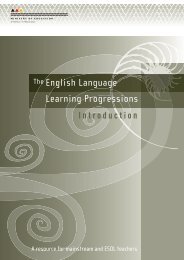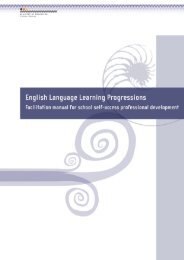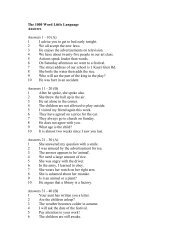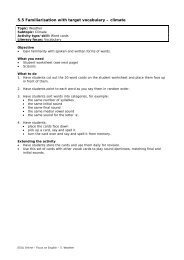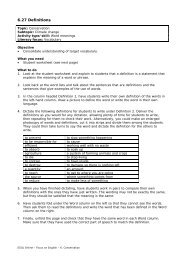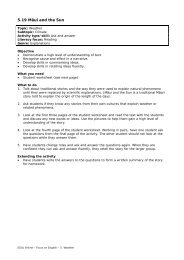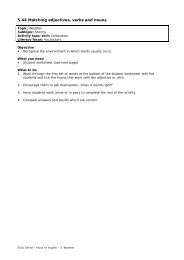ELLP Years1-4 - ESOL - Literacy Online - Te Kete Ipurangi
ELLP Years1-4 - ESOL - Literacy Online - Te Kete Ipurangi
ELLP Years1-4 - ESOL - Literacy Online - Te Kete Ipurangi
You also want an ePaper? Increase the reach of your titles
YUMPU automatically turns print PDFs into web optimized ePapers that Google loves.
Stage 1<br />
Stage 1 texts are written by learners who have developed enough knowledge of vocabulary and<br />
language structures in English to begin to write short original texts.<br />
Typical features of writing at Stage 1<br />
Topic development<br />
– <strong>Te</strong>xts are longer (at least 6–8 sentences), with some organisation of ideas.<br />
– Ideas are not generally arranged into paragraphs.<br />
– The main ideas may be expanded with details and will generally be clear to the reader.<br />
Sentence development and language structures<br />
– Sentences are mainly simple or compound (for example, linked with “and”).<br />
– The writing shows a reduced reliance on formulaic structures.<br />
– Sentence beginnings are likely to be repetitive.<br />
– Words like “because” indicate that the learner is beginning to expand texts by using complex<br />
sentence structures.<br />
– <strong>Te</strong>xts include linking words to signal the development of ideas (such as markers of time in a<br />
narrative or of cause and effect in an explanation).<br />
– Errors in words and structures are likely to be frequent and obvious. <strong>Te</strong>xts that use modelled<br />
structures will have fewer errors than texts that show more original use of language.<br />
– <strong>Te</strong>xts by learners who are literate in their first language may show attempts to use more complex<br />
structures, including direct speech or questions, but will often have errors that impede successful<br />
communication.<br />
– Additional details may be presented through a series of short sentences or through subordinate<br />
clauses.<br />
Vocabulary development<br />
– <strong>Te</strong>xts use a greater range of vocabulary. Most familiar vocabulary is likely to be accurately spelt or<br />
show phonemic awareness. Attempts to use vocabulary that learners know orally show evidence<br />
of phonemic awareness.<br />
– <strong>Te</strong>xts use some learned, topic-specific or lower-frequency vocabulary. Words may be chosen to<br />
create an effect.<br />
Script control<br />
– The script is generally readable. It may still be variable, especially with younger learners, but the<br />
form and position of letters and words are generally clearer, more consistent, and more accurately<br />
used than at earlier stages.<br />
Editing, spelling, and punctuation<br />
– There is some evidence of editing, usually teacher-directed.<br />
– Spelling may show errors that impede successful communication.<br />
– Punctuation use may range from accurate to weak or inconsistent.<br />
– Writing may show some awareness of additional punctuation features (such as speech marks and<br />
question marks) and control over full stops.<br />
49





